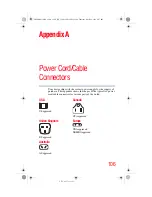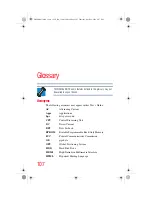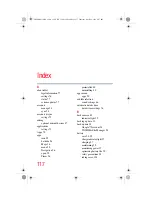
Glossary
113
I
icon
—A small image displayed on the screen that represents a function,
file, or program.
interlaced
—A method of refreshing the display screen, in which only
every other line of pixels is refreshed. Interlaced screens take two
passes to create a complete screen image. Compare
non-interlaced.
internal device
—See
device.
Internet
—The decentralized, world-wide network of computers that
provides electronic mail, the World Wide Web, and other services.
See also
World Wide Web.
L
LED (Light Emitting Diode)
—A solid state lamp (SSL) that uses
light-emitting diodes (LEDs) as the source of light, which offers
long life and high efficiency output. Multiple diodes are used
together, since the light created by individual light-emitting diodes is
small compared to incandescent and compact fluorescent lamps.
LCD (Liquid Crystal Display)
—A type of display that uses a liquid
substance between two transparent electrode panels. When an
electric current passes through the electrodes, the molecules in the
liquid form a crystalline pattern that polarizes the light passing
through it. A filter over the electrodes permits only non-polarized
light to pass to the surface of the display, creating light and dark
pixels.
M
memory
—Typically refers to the tablet’s main memory, where
programs are run and data is temporarily stored and processed.
Memory can be volatile and hold data temporarily, such as RAM, or
it can be nonvolatile and hold data permanently, such as ROM. A
tablet’s main memory is RAM. See also
RAM
,
ROM.
microprocessor
—See
Central Processing Unit (CPU).
motherboard
—The computer’s main circuit board that contains the
processor, memory, and other primary components.
mount
—To initialize the external storage device for transferring and
storing files.
multimedia
—A combination of two or more media, such as sound,
animation, and video in an application or presentation.
GMAD00314010_excite_10LE_ICS_12Apr26.book Page 113 Thursday, April 26, 2012 8:27 PM











































